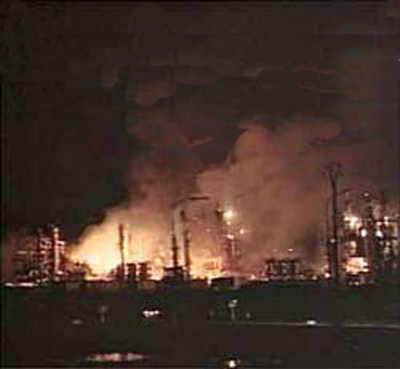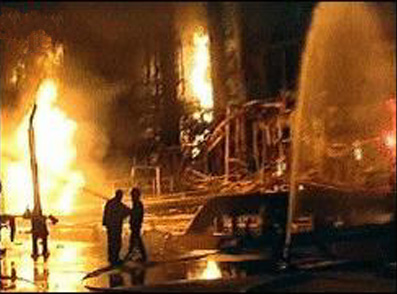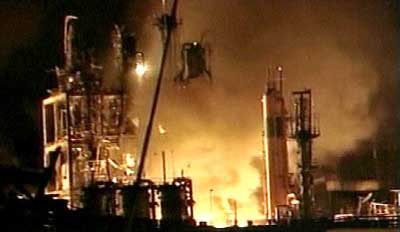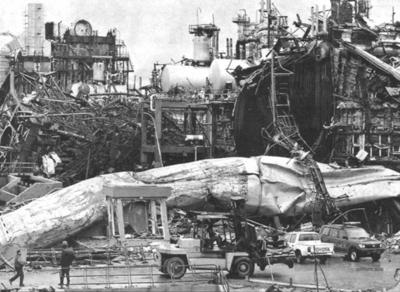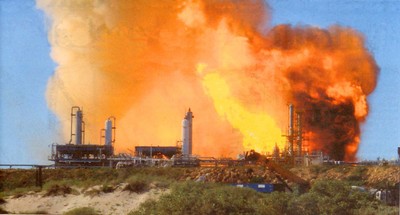Facts about LNG plants
|
The Burrup (Murujuga or Puratha) development plans of the state government of Western Australia are perverse. These images are NOT of the Woodside plant at Dampier, they are of the almost identical LNG plant at the port of Skikda, eastern Algeria, which is nearly double the size of the existing Woodside plant (it has six LNG trains). The fatal explosion at Skidka on 19 January 2004 claimed at least 27 lives and injured 72 more workers. Numerous explosions have occurred before in LNG plants, including one in Cleveland, Ohio, causing the death of 128 people and injuring almost 400. On 23 December 2003, the natural gas explosion at Chongqing, south-western China, killed 234 people and injured about 500, forcing also the evacuation of more than 40,000 residents and the treatment of over 9000 people overcome by poisonous fumes. Australia, a newcomer to the international LNG market, has only had “minor” incidents so far. The explosion at the Longford Esso facility in 1998 claimed two lives and shut down much of the economy of Victoria for two weeks. The Moomba explosion on 1 January 2004 had a similar effect on South Australia and New South Wales but miraculously caused no deaths. In a previous gas explosion at Moomba, on 15 June 2001, one worker was killed. The lesson from the Algerian and Chinese incidents, both of which occurred within the last few weeks, is two-fold. First, the US market has quickly responded by pouring cold water on the idea of the W.A government to secure huge export contracts for LNG to the American west coast. The Director of the Institute of the Americas’ Energy Program, Jeremy Martin, signaled that companies would now find it more difficult to secure government permits and financing for their ventures. Australian advocates had only shortly after the Moomba explosion and days before the Skikda explosion lobbied US Energy Secretary Spencer Abraham, claiming that Australia’s natural gas industry had an impeccable safety record.
Second, in the Algerian incident, a nearby oil refinery had to be shut down as a precaution and there was considerable damage and injury in a residential zone. LNG liquefying plants must be erected in complete isolation, which in W.A. is easy to achieve, with almost a million square miles of vacant land. Yet, the state government is determined to squeeze as many plants as possible into just one location, the central part of the Burrup Peninsula, an area of a few square kilometres. In the process, it is destroying the largest petroglyph complex in the world, an irreplaceable cultural monument of undisputed world significance. Last year alone, between 170 and 180 sites were destroyed through this obsessive zeal. Moreover, the extremely high concentration of petrochemical plants the government wants to establish next to the existing Woodside plant will greatly increase the probability of a massive industrial disaster, because an explosion can occur at each and every one of these dozen or so plants and affect those others built too close. Finally, much of the land earmarked for this development is subject to occasional surge tides, occurring once or twice a century. Such an event, engineers predict, would cause the explosion of the plants affected. The plan of the W.A. government is therefore nothing short of perverse. We are not opposed to the intelligent development of the natural gas reserves of Western Australia, but we suggest that the present plan is severely flawed. We request that construction of infrastructure by the government be halted to prevent more public spending on this doomed plan. The infrastructure is not needed, no new companies will ever set up business on the Burrup, and by persisting with its perverse plan the government is damaging not only its own credibility, but also the economic prospects of the state as a whole – and Australia’s greatest cultural monument. R. G. Bednarik February 2004 UPDATES The natural gas explosion at Ghislenghien, Belgium, on 30 July 2004, has killed 23 people and injured more than 120. Of particular concern should be the plan by Plenty River Corporation to win global explosives manufacturer Dyno Nobel for a partnership to establish a huge ammonia-urea and ammonium nitrate production complex at Dampier. A similar installation exploded on 21 September 2001 in Toulouse, France, killing 30 people and injuring more than 4900, and causing damage totalling 2.3 billion euros. This explosion involved 200 to 300 tonnes of ammonium nitrate. This is only a tiny fraction of the amount of this volatile chemical currently stored at Dampier. How much ammonium nitrate does it take to blow away the entire archipelago? An explosion at the Terra Nitrogen ammonia plant at Billington, NE England, triggered a large fire but emergency services managed to seal hydrogen and nitrogen leaks and avert a massive catastrophe. The cause of the blast is unknown. Saudi Aramco reports that 28 workers were killed in Saudi Arabia during a natural gas explosion on 18 November 2007. The accident occurred 30 km from the Hawiyah plant, which produces 310,000 barrels of ethane and LNG daily. The number of injured is not disclosed. 3 June 2008: The explosion of a gas pipeline on Varanus Island, off Western Australia, causes a massive fire burning out of control. The island is evacuated, and the incident reduces the total supply of natural gas in the state by one third. Gas rationing is introduced as supplies to industry are cut. See image on left. April 2013: An ammonium nitrate explosion at the West Fertilizer plant, in West, Texas, kills at least 14, injures over 200 and flattens 140 homes. The plant was similar to those in Toulouse, Billington and Dampier, and there have been numerous severe chemical spills, fires and other emergencies at this plant since it was commissioned. _____________________________________________________________________________________ Visit also Dampier carcinogens and Dampier fact sheets, two pages informing the public about the immense air pollution emissions of the Woodside plant at Dampier, and the health risks they pose. |
